疯子与天才之争:用双重模型估计自杀诗人的创造力
IF 4.5
2区 教育学
Q1 Social Sciences
引用次数: 0
摘要
关于“疯狂天才”的争论涉及到创造力和精神病理学之间错综复杂的关系。例如,诗人经常因心理健康问题和高自杀率而闻名。本研究运用计算机技术分析中国现当代诗人作品中的语义创造性,探讨其创作与自杀之间的关系。研究了16位自杀诗人和21位非自杀诗人,我们引入了一个结合流动距离和共现网络的双重模型来评估创造性认知。研究结果表明,自杀诗人表现出明显更高的本地和全球流动距离,反映出更大的发散思维。此外,他们的共现网络显示出更紧密的联系和更有效的结构,这表明他们的认知灵活性增强。通过证明以独特的语义网络特性为特征的高度创造力与心理健康挑战有关,该研究为“疯狂天才”假说提供了实证支持。这些结果有助于理解创造力与精神病理学之间的联系,为分析创造性表达提供了新的见解和先进的计算方法。本文章由计算机程序翻译,如有差异,请以英文原文为准。
The Mad-genius controversy: Estimating the creativity of suicide poets via a dual model
The "mad genius" controversy concerns the intricate relationship between creativity and psychopathology. Poets, for instance, are often noted for their mental health challenges and elevated suicide rates. This study investigates the link between creativity and suicide among modern and contemporary Chinese poets by employing computational techniques to analyze semantic creativity in their works. Examining 16 poets who died by suicide alongside 21 non-suicidal counterparts, we introduced a dual model that combines flow distance and co-occurrence networks to assess creative cognition. The findings indicate that suicidal poets exhibit significantly higher local and global flow distances, reflecting greater divergent thinking. Furthermore, their co-occurrence networks display more tightly interconnected and efficient structures, suggesting enhanced cognitive flexibility. By demonstrating that heightened creativity, characterized by distinct semantic network properties, is associated with mental health challenges, the study provides empirical support for the "mad genius" hypothesis. These results contribute to the understanding of the creativity-psychopathology nexus, offering novel insights and advancing computational methods for analyzing creative expression.
求助全文
通过发布文献求助,成功后即可免费获取论文全文。
去求助
来源期刊

Thinking Skills and Creativity
EDUCATION & EDUCATIONAL RESEARCH-
CiteScore
6.40
自引率
16.20%
发文量
172
审稿时长
76 days
期刊介绍:
Thinking Skills and Creativity is a new journal providing a peer-reviewed forum for communication and debate for the community of researchers interested in teaching for thinking and creativity. Papers may represent a variety of theoretical perspectives and methodological approaches and may relate to any age level in a diversity of settings: formal and informal, education and work-based.
 求助内容:
求助内容: 应助结果提醒方式:
应助结果提醒方式:


